Finding the best laser tape measure for distance measurement is like trying to identify the best work boots—one size most definitely doesn’t fit all. The very first laser distance measure I owned was a Bosch GLM15, and I still use it. Since I got it, laser distance measures have become more commonplace…. and complex. They now come with new features, calculations, and even smart connectivity. Not everyone needs all those bells and whistles, though. I’ll help you figure out the best laser distance measurer for you.
Best Laser Tape Measurer – Our Top Picks
Also In This Article
Related Content
Defining Terms
Before we jump in, let’s deal with a little bit of vocabulary. Technically, we’re talking about the best laser distance measures in this article. That’s the official name of this class of tool. However, some people call them laser distance measurers or just laser measurers. It’s a small difference, but still correct.
Then there are laser tape measures. Many people think of these devices as electronic replacements for tape measures, and even though they don’t have a measuring tape on them, the name sticks. Today, there are true tape measures with a laser measure attached to them. In this article, however, we’re primarily talking about lasers for measuring distance as opposed to those hybrid tools. That said, we’ve still got a recommendation for a hybrid laser tape measure for you.
Enough of the vocabulary lesson—let’s talk tools!
Best Laser Tape Measurer Overall
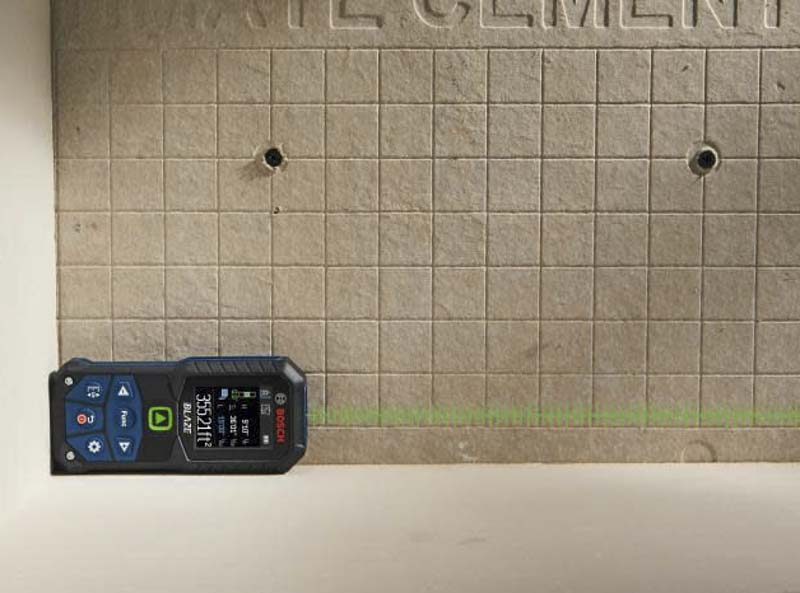
In selecting the best laser tape measurer overall, I weighed a lot of factors. For all of us, the best is the one that’s the most useful, and for this tool class, it’s easy to go overboard and overbuy. I was looking for excellent range, accuracy, tech, and size, but without having to spend $500+. While there are applications that need high-end laser distance measures, the majority of us don’t.
Enter the Bosch GLM165-27CGL—the laser measurer that has some of everything. It has a 165-foot range with a green beam that’s easier to see at longer distances and higher lighting conditions. It has 1/16-inch accuracy and a reverse contrast color screen that’s easier to read. Bluetooth connectivity lets you wirelessly transfer measurements to your phone or tablet. It’s even IP65 rated to survive in tough jobsite settings.
Pros
- Green laser beam is easier to see
- Excellent accuracy
- Bluetooth connection wirelessly transmits measurements
- Robust group of built-in calculators and angle measuring
- Haptic feedback
- Reverse contrast color screen is easy to read
- IP65 ingress rating
- Overmold improves drop protection
- Compatible with Bosch’s rechargeable GLM-BAT battery
Cons
- You may need a longer range for outdoor applications
Key Features and Specs
- 165-foot range
- ±1/16-inch accuracy
- Length, area, volume, and indirect measurements with addition and subtraction functions
- Built-in inclinometer
- Bluetooth connectivity
- IP65 ingress rating
- Runs on two AA batteries or Bosch GLM-BAT rechargeable battery
Price: $199
Best Easy-To-Use Laser Tape Measurer
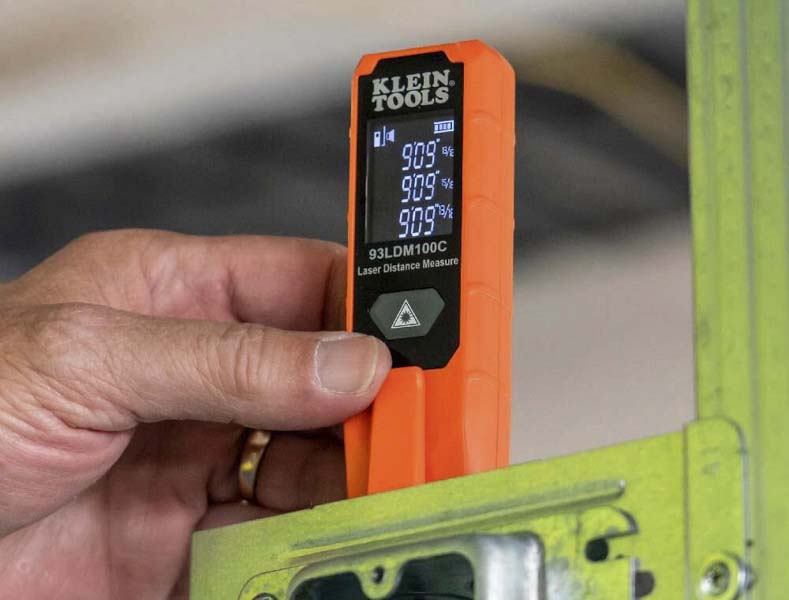

When I think about the best easy-to-use laser tape measure, I think back to my very first model—the Bosch GLM15. With just one button, the functions were easy to learn and simple to operate. That model is no longer available, but the 93LDM100C from Klein is a fine replacement.
Its one-button operation is just as easy, yet it still has multiple functions, including the ability to offer continuous measurements and switch between metric and Imperial units. Plus, the reverse-contrast backlit LCD screen is easier to read than my old unit—something my old eyes appreciate. Perhaps what’s most impressive is that Klein offers this laser measure with basic functions but outstanding accuracy at 1/16-inch and the solid range of 100 feet.
Pros
- Only one button to learn
- Compact size is easy to store in a pocket, toolbox, or drawer
- Reverse contrast backlit LCD screen
- Integrated belt clip
- Inexpensive enough even for DIY and home use
Cons
- Lacks calculation and connectivity features of more complex units
Key Features and Specs
- 100-foot range
- 1/16-inch accuracy at 30 feet, 1/8-inch accuracy at 100 feet
- IP54 ingress rating
- Runs on two AAA batteries
Price: $34.97
Most Accurate Laser Tape Measurer
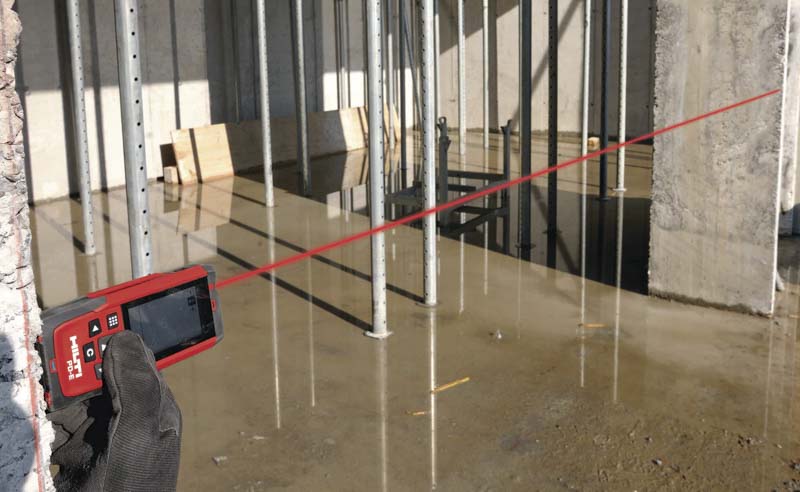

Most laser distance meters have roughly 1/8-inch accuracy at 30 feet. Many Pro models kick it up to 1/16-inch accuracy at 30 feet. For many applications, that works just fine. However, Hilti’s PD-E is the most accurate laser tape measurer we’ve found with measurements at ±1mm. That converts to just over 1/32 of an inch.
While this is an expensive laser measurer, it’s not only about accuracy. It’s specifically designed for outdoor applications with a 656-foot range, built-in viewfinder, and sun-friendly display. Plus, its IP65 ingress rating and overmold protection make it a great fit for the toughest jobsites
Pro Tip: Lighting conditions and the material you’re bouncing the laser off affect the accuracy of every laser distance measure.
Pros
- Outstanding accuracy
- Wide range of calculations on board
- Built-in tilt sensor
- Sun-friendly LCD screen
Cons
- Expensive
- Longer learning curve to master all functions
- No wireless connectivity
Key Features and Specs
- 1mm accuracy (just over 1/32-inch)
- 14 measurement modes plus add and subtract capability
- IP65 ingress rating
- Runs on two AAA batteries
Price: $629
Best Laser Tape Measurer for Outdoor Use
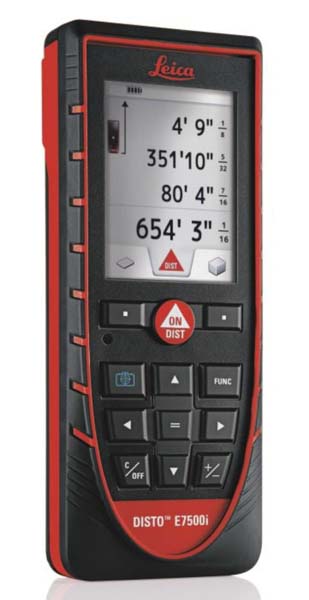

Using a laser distance measure outside presents additional challenges thanks to the sunlight. On one hand, its effective range is lower than using the same laser inside. On the other hand, your ability to see where the laser is hitting is also lower. To combat that, the best laser tape measure for outdoor use needs to address both issues. The Leica Geosystems Disto E7500i does that and more.
It has an effective range of up to 656 feet thanks to a digital camera with a 4x zoom and a boost in the laser power. But what about those times when something is in the way? Leica’s Smart Horizontal Mode includes a tilt sensor that measures the angle of the tool and corrects it to a perfectly horizontal measurement. Simply aim the laser over the obstacle and you’re in business.
Pros
- Outstanding range, even in outdoor environments
- Digital camera with 4x zoom
- Capable of correcting measurements when you need to shoot over obstacles
- Accurate measurements in challenging spots using the Multi-Functional Endpiece
- Bluetooth connectivity
- Excellent durability
Cons
- Expensive
- Takes more time to learn all the functions than other models
Key Features and Specs
- Up to 656-foot range
- 1/16-inch accuracy
- Digital camera with 4x zoom helps identify your target
- Smart Horizontal Mode corrects for vertical shift over obstacles
- Includes 14 measurement/calculation modes, including modes other models don’t have
- Multi-functional endpiece for accurate measurements in tough situations
- Wirelessly transfers measurements to photos and layouts in dedicated app
- IP65 ingress rating
- 2-meter drop rated
- Runs on two AA batteries
Price: $595.99
Best Laser Tape Measurer for DIY and Home Use
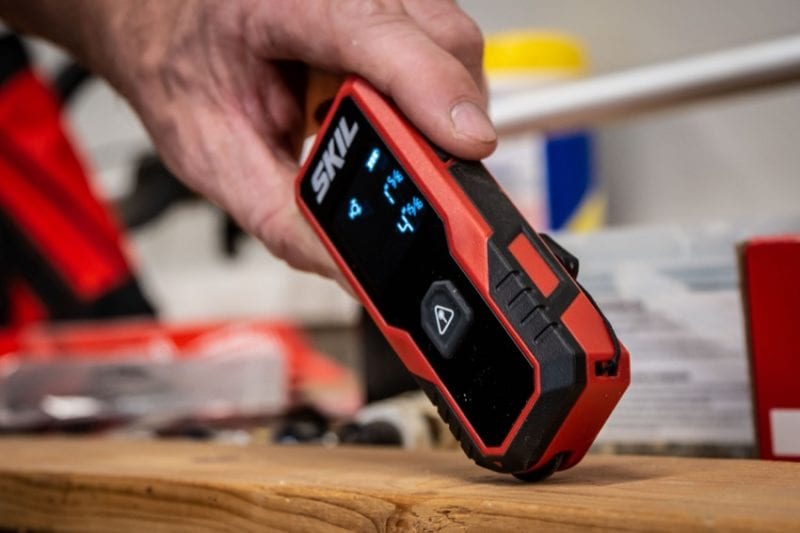

Often, people think the best laser tape measure for DIY and home use is the cheapest one they can find, but I think you should aim a little higher. Skil’s 65-foot laser distance measure addition of a measuring wheel makes it a better replacement for tape measures than most other options.
It’s the addition of a measuring wheel that makes it so versatile. When you don’t have a target to bounce the laser off (think curved objects, lumber, etc), you can run the wheel across the surface to get the measurement. It even subtracts when you pull it back. Working with either the laser or the wheel, it integrates the measurements with the automatic calculations.
The only real trade-off is slightly lower ±1/8 accuracy. That’s going to be fine for most projects, though, and the 65-foot max range covers most interior applications. Plus, this laser measure is still less than $50.
Pros
- Integrated measuring wheel handles measurements other lasers can’t
- Simple 2-button control
- Backlit reverse contrast LCD screen
- Affordable
Cons
- 1/8-inch accuracy isn’t quite as good as Pro models
Key Features and Specs
- 65-foot range
- 1/8-inch accuracy
- Length and area calculations
- Built-in measuring wheel
- Runs on two AAA batteries
Price: $49.99
Best Tape Measure with a Laser Measurer
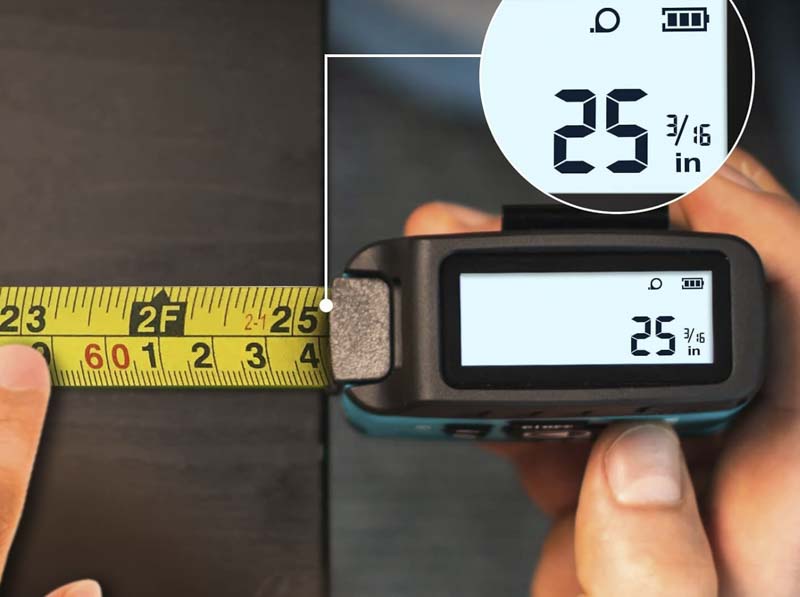

Adding a laser measure to a tape measure may sound like a great idea. However, even the best tape measure is still a consumable item on jobsites. DIYers can get much longer use from their tapes, and that’s the target user for most of these hybrid tape measures/laser measures. Even so, the majority of the major brands currently don’t offer this kind of product, so we have to travel off the beaten path a bit.
Of the options we were able to find, Mileseey’s DT20 is the one we’d pull the trigger on. It has a 16-foot combination imperial/metric blade plus a 130-foot laser measure with 1/8-inch accuracy. Though it’s more expensive than some of the other models you might consider, it includes several automatic calculations, is rechargeable, waterproof, and maintains a reasonably compact physical form.
Pros
- Better laser measure accuracy than most of its competitors
- Both tape and laser measurements appear on the LCD screen
- Automatic calculations work with tape measure or laser measure
- Waterproof
- Rechargeable
Cons
- More expensive than competing models
- Not as accurate as many dedicated laser measures
- Not as many blade features as many dedicated tape measures
Key Features and Specs
- 130-foot range
- 1/16-inch tape measure markings
- 1/8-inch laser measure accuracy
- Are, volume, and Pythagoras (2-pt and 3-pt) calculations
- Powered by an internal rechargeable battery
Price: $69.99
Best-Selling Laser Tape Measures
Interested in seeing what others are buying. Here are some of the best-selling laser tape measures at leading retailers.
Acme Tools
Amazon
Lowe’s
Home Depot
Best Laser Tape Measures – More Recommendations from Brands We Trust
Craftsman CMHT77721: 55-foot Range / ±1/4-inch Accuracy
Basic, compact, and inexpensive option with one-button control for DIYers
Price: $31.98
DeWalt DWHT77100: 100-foot Range / ±1/8-inch Accuracy
Entry-level Pro option that’s compact with two-button operation and steps up range and accuracy from the Atomic model
Price: $86.99
Fluke 424D: 330-foot Range / ±1/32-inch Range
High-end Pro model with incredible 1mm accuracy, inclinometer, compass, corner angle measurements, and much more
Price: $494.99
Johnson Level LDM330: 330-foot Range / ±1/16-inch Accuracy
Solid Pro-grade model with Bluetooth connectivity and built-in angle sensor
Price: $199.99
Kobalt SLM-55LI: 55-foot Range / ±1/4-inch Accuracy
Basic, compact, and inexpensive option with one-button control for DIYers
Price: $29.98
Makita LD080P: 262-foot Range / ±1/16-inch Accuracy
Pro-grade model with a flip-out endpiece to measure around corners and edges with a jobsite-tough build
Price: $204
Milwaukee 48-22-9803: 330-foot Range / ±1/16-inch Accuracy
Pro model with digital auto leveling, Side Shot button, corner/edge measurement lever, backlit color screen, and IP54 ingress rating
Price: $159
Stabila LD220: 100-ft Range / ±1/8-inch Accuracy
Entry-level Pro laser that’s easy to learn and built to survive on jobsites (also available with Bluetooth connectivity)
Price: $117.60
Ryobi ELDM65: 65-Foot / ±5/64-inch Accuracy
DIY-focused option with simple, one-button operation and a reverse-contrast screen
Price: $44.97
Best Laser Tape Measurer Frequently Asked Questions
How Far Do Laser Distance Measures Measure?
The first question you need to ask is: How far do you typically need to measure? Do you work mostly indoors or outside (in the sunlight)? Do you mostly focus on residential projects or commercial ones?
Using Laser Measures Outdoors: Keep in mind that laser measures do work outdoors. Even though you may not be able to see the laser, it’s accurate if it falls within its range of use. Still, you do need to be certain you hit the right target! (See the “What is a Digital Viewfinder” section below)
If you’re working on residential jobs, 50 feet of range often covers your needs for indoor measurements. If you estimate fencing or other outdoor products, you may want to go with a tool capable of greater distances.
Commercial applications usually require larger distance measurements, so a longer-range tool makes sense. The further a laser distance measure can measure, the more powerful the laser and sensor need to be.
Make the Call: Consider the longest measurements you need a laser distance measure for. Get a model that will extend a little beyond that.
How Much Memory or Storage Do I Need?
A basic laser distance measure doesn’t have any memory storage. The best it will give you is the ability to hold a measurement. Others might give you storage for up to 200 measurements or more. Decide how comfortable you are recording measurements in a notebook or on your phone. If you’re a good note-taker or don’t want to trust technology, memory might not be a big deal. On the other hand, storing those figures right in the tool makes for a potentially quicker workflow.
Make the Call: This is a judgment call. I like a laser measure with at least 50 data points of storage so I can have an entire house’s worth of measurements. I still record them in a notebook, though.
What are the Best Kinds of Screens for Laser Distance Measures
The two major screen types you’ll find are LCD and LED. LED is much brighter and easier to read. This really helps in bright sunlight. Many LCDs have a backlight that helps in low light conditions, but they can be tough to read in direct sun. “Inverted” colors also help as white text on a dark background is easier to read in the sun than black text on white.
Make the Call: Both screens work just fine, but we prefer LED and the option for inverted screens if we have a choice.
Are Color LCD Screens Necessary?
We keep seeing new-fangled products with full-color LCDs. So far, this hasn’t proved terribly helpful. There are, however, some specific instances where a full-color screen may help. In particular, models with built-in cameras make for much more impressive estimating documentation at the end of the job. Still, other models serve as long-distance rangefinders, helping you find that dot that might be as far as several hundred yards away.
Can Laser Distance Measures Give You Real-Time Measurements?
Typically, yes. Real-time measurements give you instant feedback as you move the laser rather than waiting for you to press a “measure” button. It gives you the ability to find an exact distance away from a wall or ceiling so you can make a mark before punching a hole through it. None of our Pro team is interested in a laser distance meter that doesn’t have this feature.
Make the Call: In our opinion, the real-time measurement function is a must-have feature.
Does it Support Addition/Subtraction?
Addition and subtraction are handy features to have when you need to combine two lengths that you can’t measure in one shot. They also help when you need to exclude part of a measurement. It works in conjunction with distance, area, and volume as well. If you’re doing an estimate for painting, it’s an easy way to take out the area of garage doors and other large non-paintable areas as you go.
Make the Call: This is a function you’ll find on all but the most basic laser distance measures, and it’s pretty helpful on area calculations in particular.
Can It Calculate Area and Volume?
Chances are that if your laser measure has addition and subtraction, it will also have area, volume, and indirect measurement (see below). This simply allows you to take two (for area) or three (for volume) measurements and automatically get the result. When estimating for paint, drywall, flooring, airflow, and more, we consider this an essential function.
Make the Call: Aside from making a basic measurement, area and volume functions are among the most helpful. You probably want it on your laser distance meter.
Can You Take an Indirect Measurement (use the Pythagorean Theorem)?
Indirect measurement goes hand in hand with area and volume functions. The difference is that you measure straight to the base of the material (the leg of the right triangle) and from the same point to the top of the material (the hypotenuse) to get a height that you can’t measure directly.
Make the Call: This one’s not a make-or-break feature for most of our team, but you’ll probably get it along with area and volume. It’s actually a really cool feature if you find yourself needing it. An advancd version of this also integrates an angle measurement. This lets you measure various heights at a distance—even off the ground.
Is a Wireless Connection (Bluetooth) Helpful?
Getting data off the tool is almost as important as getting it in if you do estimates and bids. If you’re on the tech-savvy side of things, a Bluetooth connection can help you transfer data from your laser distance measure to your phone, tablet, or computer.
There’s likely an app to go along with it as well. Some apps even give you the ability to overlay measurements on pictures or drawings of the work. When putting together a bid or quote, this lets you show your client visuals and bring an extra layer of professionalism to your proposal.
Make the Call: There’s a learning curve that comes with adding this layer of technology. Those who learn to use it can save tons of time and produce much more data-rich proposals and estimates. While Bluetooth is helpful in laser measures, it’s not an industry standard, so it’s completely up to your comfort level if you want it.
What is a Digital Viewfinder and How Does It Help?
A digital viewfinder is most helpful on a long-range laser distance measure where it’s difficult to see where the laser dot lands. When you’re measuring distances closing in on 400 feet, being off by a couple of degrees can make a big difference in your results.
Make the call: You can only see red lasers out to so far before you need to bounce it off a target card and possibly have a second person helping. The digital viewfinder is really helpful for longer range outdoor applications.
Should I Get a Model with a Camera?
Some laser distance measures add a camera to their digital viewfinder. This can make it easier to generate a photo with measurement layovers. This works alongside a Bluetooth connection to transfer the results into an app. This feature appears on high-end laser measures and comes at a premium price.
Other systems featuring camera integration function as rangefinders. These help you “zoom in” on far-away objects you’re trying to hit with that little red dot.
Your Choice: This is most helpful on commercial sites where there’s a lot of technology in place to get information where it needs to go quickly. However, using technology like this as a residential contractor will definitely set you apart.
Lithium-ion Rechargeable or Battery as a Power Source?
Many laser distance meters use AAA or AA batteries as a power source, though some have an integrated lithium-ion battery. Standard alkaline batteries are relatively inexpensive and easy to find. Rechargeable batteries make sense for some of the larger, more powerful models and keep you from having to carry around spares…as long as you remember to charge them!
Make the Call: There’s not really a bad call here. Alkaline batteries will keep your initial cost down and lithium-ion is more convenient. I like lithium-ion, but the majority of our laser distance meters are alkaline.
How Much do Laser Tape Measurers Cost?
How much you’re willing to spend is another first thing to consider. Laser measures can cost as little as $20. Commercial units might run more than $1,000. The latter will deliver longer ranges. They might also connect to a laptop and provide the ability to estimate roofing, enter data into CAD files, etc.
You want to find a laser distance measure that checks off all your needs and stays within budget. Any of the bonus features you can get for the same price are, well, a bonus!
Why You Can Trust Pro Tool Reviews
Ever check out a “review” site and you can’t tell if they actually tested the tools or if they’re just “recommending” the Amazon top sellers?
That’s not us. We only recommend what we’d use, even if we don’t earn a commission from it. It’s all about giving you a legitimate recommendation and our honest opinion of each product.
We’ve been covering tools, writing reviews, and reporting on industry news in the construction, automotive, and lawn care industries since 2008. Our Pro reviewers work in the trades and have the skills and experience to know whether tools can perform well in the field.
Each year, we bring in and review more than 150 individual products. Our team will put our hands on hundreds of additional tools at media events and trade shows throughout the year.
We consult with innovators in the technology and design of tools to gain a broader grasp of where these products fit and how they work.
We work with more than two dozen professional contractors around the United States who review products for us on real job sites and consult with us on testing methods, categories, and weighting.
We’ll provide more than 500 pieces of new content this year absolutely free for our readers—including objective evaluations of individual tools and products.
The result is information you can trust because of the editorial, scientific, and real-world professional experience we collectively utilize each and every time we pick up and test a tool.





